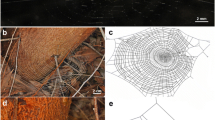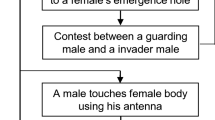Abstract
The male giant water bug'sLethocerus deyrollei counterstrategy against egg mass destruction by the female was investigated in the laboratory. When mature females encounter a brooding male, they destroy his egg mass and thereby take over the mate and gain a nurse for their own egg mass. However, when the male stays on egg masses laid above the water surface, females cannot detect the male nor the egg mass. Eggs of this species fail to hatch without being supplied with water by males. In the observation, brooding males frequently ascend the stick to the egg mass and stay there for long periods, although most of the water attached to their body surface flowed down in 90 s. These long stays on egg masses are regarded as countestrategies against females.
Similar content being viewed by others
References
Bertram, B. C. R. (1975). Social factors influencing reproduction in wild lions.J. Zool. London 177 463–482.
Crockett, C. M., and Sekulic, R. (1984). Infanticide in red howler monkeys (Alouatta seniculus). In Hausfater, G., and Hrdy, S. B. (eds.),Infanticide, Aldine, New York, pp. 173–191.
Freed, L. A. (1986). Territory takeover and sexually selected infanticide in tropical house wrens.Behav. Ecol. Sociobiol. 19 197–206.
Fujioka, M. (1986). Infanticide by a male parent and by a new female mate in colonial egrets.Auk 103 619–621.
Hrdy, S. B. (1979). Infanticide among animals: A review, classification, and examination of the implications for the reproductive strategies of females.Ethol. Sociobiol. 1 13–40.
Hausfater, G. (1984). Infanticide in langurs: Strategies, counterstrategies, and parameter values. In Hausfater, G., and Hrdy, S. B. (ed.),Infanticide, Aldine, New York, pp. 257–281.
Ichikawa, N. (1988). Male brooding behaviour of the giant water bugLethocerus deyrollei Vuillefroy (Hemiptera: Belostomatidae).J. Ethol. 6 121–127.
Ichikawa, N. (1989). Repeated copulations benefit of the female inLethocerus deyrollei Vuillefroy (Hetroptera: Belostomatidae).J. Ethol. 7 113–117.
Ichikawa, N. (1990). Egg mass destroying behaviour of the female giant water bugLethocerus deyrollei Vuillefroy (Heteroptera: Belostomatidae).J. Etho. 8 5–11.
Ichikawa, N. (1991a). Egg mass destroying and guarding behaviour of the giant water bugLethocerus deyrollei Vuillefroy (Heteroptera: Belostomatidae).J. Ethol. 9 25–29.
Ichikawa, N. (1991b). Additional benefit of egg mass destruction by giant water bugLethocerus deyrollei Vuillefroy (Heteroptera: Belostomatidae) Females.J. Etho. 9 34–36.
Ichikawa, N. (1993). Biased operational sex ratio causes the female giant water bugLethocerus deyrollei to destroy egg masses.J. Ethol. 11 151–152.
Møller, A. P. (1988). Infanticidal and anti-infanticidal strategies in the swallowHirundo rustica.Behav. Ecol. Sociobiol. 22 365–371.
Robertson, R. J., and Stutchbury, B. J. (1988). Experimental evidence for sexually selected infanticide in tree swallows.Anim. Behav. 36 749–753.
Smith, R. L., and Larsen, E. (1993). Egg attendance and brooding by males of the giant water bugLethocerus medius (Guerin) in the field (Heteroptera: Belostomatidae).J. Insect Behav. 6 93–106.
Stephens, M. L. (1982). Mate takeover and possible infanticide by a female northern jacanaJacana spinosa.Anim. Behav. 30 1253–1254.
Suguyama, Y. (1965b). On the social change of hanuman langurs (Presbytis entellus) in their natural condition.Primates 6 381–418.
Trumbo, S. T. (1990). Reproductive benefits of infanticide in a biparental burying bettleNicrophorus orbicollis.Behav. Ecol. Sociobiol. 27 269–273.
Veiga, J. P. (1990). Infanticide by male and female house sparrows.Anim. Behav. 39 496–502.
Author information
Authors and Affiliations
Rights and permissions
About this article
Cite this article
Ichikawa, N. Male counterstrategy against infanticide of the female giant water bugLethocerus deyrollei (Hemiptera: Belostomatidae). J Insect Behav 8, 181–188 (1994). https://doi.org/10.1007/BF01988903
Accepted:
Issue Date:
DOI: https://doi.org/10.1007/BF01988903




